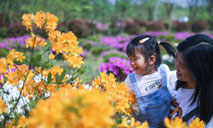Chinese agricultural heritages benefit world
The rice-fish culture system in Qingtian County, east China’s Zhejiang Province. (Photo from the official website of China Agricultural Museum)
During the long history of human development, farmers and herdsmen across the world have created unique agricultural skill systems and accumulated abundant management experiences over the long course of production, establishing particular agricultural systems and farming landscapes.
Such agricultural heritage systems embody the value orientations, experiences, traditions and folks cultures of mankind.
According to the core values of their protection and exploitation, agricultural heritage can be divided into four major types, including compound ecology, crop resources, livestock and poultry resources and traditional skills.
As a traditional agricultural country, China possesses the most complete agricultural heritage types, the richest animal and plant resources, the most abundant traditional knowledge system, and the longest history of agricultural heritage.
As of the end of 2020, the Food and Agriculture Organization (FAO) of the United Nations had designated 62 systems across the world as agricultural heritage sites. China is home to 15 of these sites, ranking the first in the world.
China is one of the first countries responding to the initiative for the conservation and adaptive management of Globally Important Agricultural Heritage Systems (GIAHS). In 2012, it initiated the program of China Nationally Important Agricultural Heritage Systems. As of today, 118 agricultural heritage sites across the country have been approved in five batches.
In May 2005, five sites around the world were selected by the GIAHS, including the 1,200-year-old rice-fish culture system in Qingtian County, east China's Zhejiang Province.
What’s unique about the system is that fish are kept in paddies. They not only soften the soil, but also eat plant hoppers and weeds in the fields. Besides, their excrement also serve as fertilizers. As reciprocity, rice plants provide shades for fish. Such a compound ecological system mirrors a philosophy of sustainable development, and shall be inherited and further exploited.
The rice-fish culture system has been promoted by the FAO in many countries in Africa and Southeast Asia. Six years ago, the GIAHS Secretariat launched a training program in Qingtian about the rice-fish culture system, after which the system was promoted in Uganda, Kenya, Madagascar and countries in West Africa. The Chinese agricultural heritage system has become an important way for these countries to eliminate poverty and develop economy.
Hani Rice Terraces, located in Yuanyang, Honghe, Lvchun and Jinping of Honghe Hani and Yi Autonomous Prefecture, southwest China's Yunnan Province, cover a total area of 820,000 mu, or 54,666 hectares. Over 200,000 mu of the terraces are distributed along the south part of the Ailao Mountain that stretches across the above four counties, enjoying a history of more than 1,300 years. Hani Rice Terraces are both a GIAHS site and a UNESCO World Heritage site.
Yuanyang red rice is a traditional variety that has been planted in the region for hundreds of years. As it contains unique resistance gene against rice blast, rice diseases hardly occurred there.
Scientific achievements deriving from the plantation in Hani Rice Terraces are expected to benefit the world. If the resistance gene in the rice can be effectively used to nurture new varieties, rice fertilizers would be a thing in the past, which reduces pesticide residue and cut environmental pollution.
Besides, the studies on the resistance gene would also inspire the studies on the insect-resistant gene, hardiness gene, aroma gene and high protein gene of crops.
(Zhu Guannan is the deputy director of the Agricultural Heritage Society, Chinese Association of Agricultural Science Societies.)
 |
Photos
Related Stories
Copyright © 2021 People's Daily Online. All Rights Reserved.











